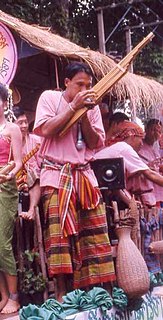
Thai, Central Thai, is the national language of Thailand and de facto official language; it is the first language of the Central Thai people and most Thai Chinese, depending on age. It is a member of the Tai group of the Kra–Dai language family, and one of over 60 languages of Thailand. Over half of Thai vocabulary is derived from or borrowed from Pali, Sanskrit, Mon and Old Khmer. It is a tonal and analytic language, similar to Chinese and Vietnamese.

Lao, sometimes referred to as Laotian, is a Kra–Dai language of the Lao people. It is spoken in Laos, where it is the official language, as well as northeast Thailand, where it is usually referred to as Isan. Lao serves as a lingua franca among all citizens of Laos, who speak approximately 90 other languages, many of which are unrelated to Lao.
The Lao people or Laotians are a Tai ethnic group native to Southeast Asia, who speak the eponymous language of the Kra–Dai languages, originating from present-day southern China. They are the majority ethnic group of Laos, making up 53.2% of the total population. The majority of Lao people adhere to Theravada Buddhism. They are closely related to other Tai peoples, especially with the Isan people, who are also speakers of Lao language, but native to neighboring Thailand.

Northeast Thailand or Isan consists of 20 provinces in the northeastern region of Thailand. Isan is Thailand's largest region, located on the Khorat Plateau, bordered by the Mekong River to the north and east, by Cambodia to the southeast and the Sankamphaeng Range south of Nakhon Ratchasima. To the west it is separated from northern and central Thailand by the Phetchabun Mountains.

Surin is one of Thailand's seventy-seven provinces (changwat) lies in lower northeastern Thailand also called Isan. Neighboring provinces are Buriram, Maha Sarakham, Roi Et, and Sisaket. To the south it borders Oddar Meancheay of Cambodia. Surin covers a total area of 8,124 km2 (3,137 sq mi) from the Mun River in the north to the Dangrek Mountains in the south. The capital, Surin city, in the western central region province is 434 km from Bangkok.

Mor lam is a traditional Lao form of song in Laos and Isan. Mor lam means 'expert song', or 'expert singer', referring to the music or artist respectively. Other romanisations used include mor lum, maw lam, maw lum, moh lam, mhor lum, and molum. In Laos, the music is known simply as lam (ລຳ); mor lam (ໝໍລຳ) refers to the singer.
Isan or Northeastern Thai refers to the local development of the Lao language in Thailand, after the political split of the Lao-speaking world at the Mekong River, with the left bank eventually becoming modern Laos and the right bank the Isan region of Thailand after the conclusion of the Franco-Siamese War of 1898. The language is still referred to as the Lao language by native speakers. As a descendant of the Lao language, Isan is also a Lao-Phuthai language of the Southwestern branch of Tai languages in the Kra-Dai language family, most closely related to its parent language Lao and 'tribal' Tai languages such as Phuthai and Tai Yo. Isan is officially classified as a dialect of the Thai language by the Thai government, although Thai is a closely related Southwestern Tai language, it falls within the Chiang Saen languages. Thai and Lao are mutually intelligible with difficulty, as even though they share over 80% cognate vocabulary, Lao and Isan have a very different tonal pattern, vowel quality, manner of speaking and many very commonly used words that differ from Thai thus hampering inter-comprehension without prior exposure.

The history of Isan has been determined by its geography, situated as it is on the Korat Plateau between Cambodia, Laos, and Thailand.
Southern Thai, also known as Pak Thai or Dambro, is a Southwestern Tai ethnolinguistic identity and language spoken in the fourteen provinces of southern Thailand as well as by small communities in the northernmost Malaysian states. It is spoken by roughly five million people, and as a second language by the 1.5 million speakers of Pattani and other ethnic groups such as the local Thai Chinese communities, Negritos, and other tribal groups. Most speakers are also fluent in or understand the Central Thai dialects.

Thai people, Central Thai or Siamese, in a narrow sense, are a Tai ethnic group dominant in Central and Southern Thailand. Part of the larger Tai ethno-linguistic group native to Southeast Asia as well as Southern China and Northeast India, Thais speak the Central Thai language, which is classified as part of the Kra–Dai family of languages. The majority of Thais are followers of Theravada Buddhism.
The Lao Nyaw, Thai Nyaw or Tai Yo are an ethnic group of Thailand, Cambodia and Laos, scattered throughout the provinces of Isan such as Nong Khai, Sakon Nakhon, Nakhon Phanom, and parts of Bolikhamxai and Khammouan provinces of Laos. They are also referred to as simply Nyaw or Yaw, depending on either the Lao, Isan, and Nyaw pronunciation, which all pronounce the initial consonant as, or the Thai pronunciation, which pronounces the initial consonant as.

The largest of the ethnic groups in Cambodia are the Khmer, who comprise approximately 90% of the total population and primarily inhabit the lowland Mekong subregion and the central plains. The Khmer historically have lived near the lower Mekong River in a contiguous arc that runs from the southern Khorat Plateau where modern-day Thailand, Laos and Cambodia meet in the northeast, stretching southwest through the lands surrounding Tonle Sap lake to the Cardamom Mountains, then continues back southeast to the mouth of the Mekong River in southeastern Vietnam.
Northern Khmer, also called Surin Khmer, is the dialect of the Khmer language spoken by approximately 1.4 million Khmer native to the Thai provinces of Surin, Sisaket, Buriram and Roi Et as well as those that have migrated from this region into Cambodia.
Thailand is a country of some 70 ethnic groups, including at least 24 groups of ethnolinguistically Tai peoples, mainly the Thai, Lao, and Yuan; 22 groups of Austroasiatic peoples, with substantial populations of Northern Khmer and Kuy; 11 groups of Sino-Tibetan peoples, with the largest in population being the Karen; 3 groups of Austronesian peoples, i.e., the Malay, the majority ethnic group in the southernmost three provinces, together with the Moken and Urak Lawoi ; and both groups of Hmong-Mien. Other ethnic groups include longstanding immigrant communities such as the Chinese and Indians.
The Lao Wiang, sometimes also referred to as Lao Wieng, are a Tai sub-ethnic group of the Isan region. Approximately 50,000 self-proclaimed Lao Wiang live in villages throughout Thailand, especially the provinces of Prachinburi, Udon Thani, Nakhon Pathom, Chai Nat, Lopburi, Saraburi, Phetchaburi, and Roi Et with a significant number in Bangkok.
The Lao Ga, are a Tai sub-ethnic group of Lao people.

Thailand is home to 71 living languages, with the majority of people speaking languages of the Southwestern Tai family, and the national language being Thai. Lao is spoken along the borders with the Laos PDR, Karen languages are spoken along the border with Myanmar, Khmer is spoken near Cambodia and Malay is spoken in the south near Malaysia. Sixty-two 'domestic' languages are officially recognized, and international languages spoken in Thailand, primarily by international workers, expatriates and business people, include Burmese, Karen, English, Chinese, Japanese, and Vietnamese, among others.

The Isan people or Northeastern Thai people are an ethno-regional group native to Northeastern Thailand ("Isan") with an estimated population of about 22 million. Alternative terms for this group are T(h)ai Isan, Thai-Lao, Lao Isan, or Isan Lao. Like Thais (Siamese) and Lao, they belong to the linguistic family of Tai peoples.

Tai people refers to the population of descendants of speakers of a common Tai language, including sub-populations that no longer speak a Tai language. There is a total of about 93 million people of Tai ancestry worldwide, with the largest ethnic groups being Dai, Thais, Isan, Tai Yai, Lao, Ahom, and Northern Thai peoples.
The Kuy are an indigenous ethnic group of mainland Southeast Asia. The native lands of the Kuy range from the southern Khorat Plateau in northeast Thailand east to the banks of the Mekong River in southern Laos and south to north central Cambodia. The Kuy are an ethnic minority in all three countries, where they live as "hill tribes" or Montagnards. Their language is classified as a Katuic language of the Mon-Khmer language family and, as such, is related to the Khmer language of Cambodia. The Thais, Lao, and Khmer traditionally recognize the Kuy as the aboriginal inhabitants of the region and refer to them as Khmer boran (Khmer), meaning "ancient Khmer" or Khamen pa dong. The word kuy in the Kuy language means "people" or "human being"; alternate English spellings include Kui, Kuoy and Kuay, while forms similar to "Suay" or "Suei" are derived from the Thai/Lao exonyms meaning "those who pay tribute". The Kuy are known as skilled mahouts, or elephant trainers, and many Kuy villages are employed in finding, taming, and selling elephants.










